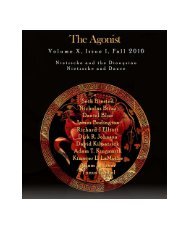Volume XII, Issue II, Spring 2019
Create successful ePaper yourself
Turn your PDF publications into a flip-book with our unique Google optimized e-Paper software.
PETER S. GROFF<br />
whether the question of human self-sculpture in the aftermath of the death of<br />
God might be brought even more sharply into focus by explicitly considering the<br />
Platonic ideal of homoiōsis theōi (becoming like god), which seems to hover in the<br />
background of much of the early philosophical sculpture literature. The theme is<br />
enormously important in Greek and Hellenistic philosophy and it gets taken up<br />
and thought through quite thoroughly in an Abrahamic context by a host of<br />
Islamic and Jewish thinkers during the medieval period. It might prove a useful<br />
foil for understanding the inherent tensions in Zarathustra’s experimental<br />
cultivation of the Superman, since (1) he adopts and retains the Neoplatonic<br />
assumption that sculpting is essentially removal of the inessential, yet (2) there is<br />
no preexisting paradigm or telos to be discovered or revealed, and (3) he speaks<br />
both here and elsewhere of the “completion” or “perfection” (Vollkommenheit) of<br />
the human being. Be that as it may, we are deeply indebted to Bishop for having<br />
explored the motif of self-sculpture so thoroughly, and one’s reading of<br />
Zarathustra (and Nietzsche’s corpus in general) cannot but be much richer as a<br />
result of it.<br />
At the very end of Chapter 2, Bishop observes that the appeal to embark on<br />
a path of self-transformation implies dissatisfaction with the current shape of<br />
things. “But does wanting something else—or wanting something better—imply<br />
one believes there can actually be something better?” he asks, “Or that there is<br />
something one could call the best? Does it imply one believes in something that<br />
might be called—the ideal . . . ?” (129). This question sets the stage for Chapter 3,<br />
which attempts to synthesize the shadow and sculpting themes. Bishop<br />
approaches this through a close reading of Schiller’s poem “The Ideal and Life”<br />
(Das Ideal und das Leben), which attends to its developmental history as well as its<br />
thematic relation to a projected (albeit unwritten) subsequent poem on Heracles’<br />
arrival, divine transfiguration and joyful blessedness in Olympus. The central<br />
theme of the poem, which Bishop brings to bear on Zarathustra, is the perpetual<br />
accessibility of the ideal amidst the struggle and strife of life, via both intellectual<br />
contemplation and aesthetic creativity. While this may at first seem like an escapist<br />
fantasy, he emphasizes the ideal’s capacity to invigorate and transform life in the<br />
here and now. The transfiguration of the present moment by means of “the<br />
eternal within,” he calls it, leads into an extended reflection on the meaning of<br />
the Blissful Islands (glückseligen Inseln).<br />
This is a welcome contribution to the literature, since the theme of the Blissful<br />
Islands in Zarathustra has not as yet received any sustained treatment. Bishop lays<br />
the groundwork for his discussion in the opening section of Chapter 1, where he<br />
57









